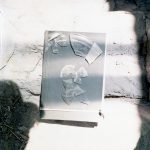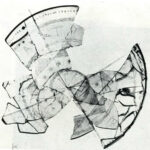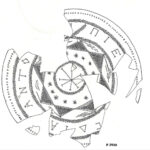| Artefact ID | 1279 |
| TM ID | TM 32985 |
| Findspot (DEChriM ID) | 70 (Wādī Qiṭna) | Class | Cooking/table/transport/storage ware, Textual |
| Material | Glass |
| Writing medium | Inscription |
| Text content | Subliterary |
| Language | Greek |
| Description | SEG LIII 1921 (4); SB XVIII 13721; SEG XXXIV 1632: Flat, rounded plate or saucer of colourless transparent glass. Engraved decoration executed negatively on the outer side, so that it is seen positively on the inner side. The ornament consists of geometrical designs and stylized twigs arranged in concentric circles. There is a large chrism in the middle, surrounded by a vegetal wreath, another ring being formed by eight-pointed stars (originally there were 16 of them) and octagons of wide, cross-hatched triangles which come into mutual contact with their bases. More outwardly two wreaths frame a Greek inscription, engraved in square letters, which was restored "with a high degree of probability" and reads: ΠΙΕ ΖΗΣΑΙΣ ΔΙΑ ΠΑΝΤΟΣ ΑΕΙ, "Drink, may you live long and for ever". The christogram is of the rare type that has an extra horizontal stroke across the centre and assumed to derive from the double cross. |
| Selection criteria | Christian symbols/gestures/isopsephy |
| Date from | 300 |
| Date to | 350 |
| Dating criteria | Dated ca. 300-330 in ed.pr. but 4th – early 5th c. by Nenna 2003: 369-370. A similar plate of colourless transparent glass was found in Augsburg, in 2000 (Römisches Museum, Augsburg, inv. no. 2000,4189). Decorated, in its centre, with an Adam and Eve flanking the Tree of the Knowledge scene, it bears on the lip a circular Latin inscription reading VIVAS IN DEO, as well as a chrism and the letters Π and Ζ, standing for ΠΙΕ ΖΗΣΑΙΣ, "Drink, may you live!" ‒ an inscription similar to the one on the plate from Wādī Qiṭna. The plate from Augsburg, so far the earliest material source documenting Christianity in Bavaria, has been dated to 340-350. |
| Absolute/relative date | Relative date |
| Archaeological context | Part of the grave furniture placed in the burial chamber of tumulus 15A in the Wādī Qiṭna cemetery. |
| Accession number | Prague, Náprstek Museum P 2920 |


 Json data
Json data





